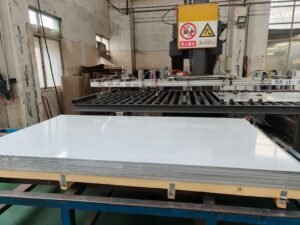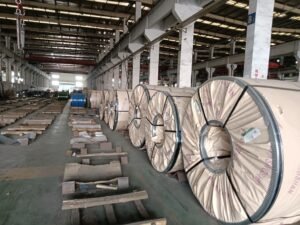Introduction
Choosing the wrong channel steel can derail your project, compromising structural integrity and inflating costs. UPN & UPE channel steel profiles each offer unique strengths, but picking the right one depends on your project’s demands for stability, weight, and fabrication ease.
From heavy-duty bridges to sleek commercial builds, these European standard profiles shine in distinct applications. This guide breaks down their differences, performance metrics, and real-world uses, with insights from suppliers like HnL Steel, to help engineers and construction pros make informed decisions.
Introduction to UPN and UPE Channel Steel
Channel steel is a vital component in construction and engineering, offering strength and versatility for various projects. Among the most widely used types are UPN & UPE channel steel, which follow European standards and are known for their reliability in structural applications. This chapter introduces these profiles, their significance, and how choosing the right one can make or break a project’s success.
What Are Channel Steels?
Channel steels are metal beams with a U-shaped cross-section, often used to provide structural support. They come in various sizes and standards, with UPN & UPE channel steel being popular in Europe. Their design allows them to bear heavy loads, making them ideal for frameworks, bridges, and buildings.
HnL Steel, a trusted supplier, offers high-quality UPN channel and UPE channel options. With flexible payment terms and fast delivery, they ensure project efficiency. Their expertise helps clients pick the best channel for specific needs.
Role in Structural Applications
Channel steels are the “backbone” of many structures, distributing weight and resisting bending forces. They’re commonly used in columns, beams, and bracing systems. Their ability to handle dynamic loads makes them essential for skyscrapers, warehouses, and industrial facilities.
Unlike other steel profiles, channels offer a balance of strength and weight. This makes them cost-effective for projects requiring durability without excess material. Professionals rely on them for both temporary and permanent structures.
Overview of UPN and UPE Profiles: European Standards
The UPN channel has tapered flanges, providing excellent resistance to torsional forces. In contrast, the UPE channel features parallel flanges, which simplify connections and improve compatibility with modern designs. Both adhere to strict European standards, ensuring consistency and quality.
UPN profiles are often chosen for traditional construction, while UPE profiles suit projects needing streamlined assembly. Understanding their differences is key to optimizing performance. HnL Steel’s team guides clients through this channel steel comparison to ensure the right fit.
UPN and UPE channel steels offer distinct advantages, with UPN’s tapered flanges excelling in torsion resistance and UPE’s parallel flanges easing assembly for modern projects.
Importance of Choosing the Right Channel for Project Success
Selecting between UPN and UPE channels can impact a project’s cost, timeline, and safety. For example, using the wrong profile might lead to structural weaknesses or higher material costs. Knowing how to choose between UPN and UPE channels ensures efficiency and longevity.
HnL Steel provides case studies showcasing real-world applications, a gap often missing in competitor content. Their insights help professionals make informed decisions, backed by reliable sourcing and technical support.
Brief Insight into Industry Trends for Structural Steel
The structural steel industry is leaning toward sustainable materials and modular construction. UPN and UPE channels are adapting, with manufacturers improving production to reduce waste. Demand for lightweight, high-strength profiles is also rising, driven by eco-conscious designs.
HnL Steel stays ahead by offering customized solutions and fast delivery. Their focus on quality assurance aligns with global trends, making them a go-to for innovative projects.
UPN vs. UPE Channel Steel Comparison
| Feature | UPN Channel | UPE Channel | Typical Application | Industry Benchmark |
|---|---|---|---|---|
| Flange Design | Tapered | Parallel | Framework vs. Modular | Parallel Preferred |
| Torsional Resistance | High (8/10) | Moderate (6/10) | Bridges vs. Buildings | 7/10 |
| Connection Ease | Moderate (6/10) | High (9/10) | Traditional vs. Prefab | 8/10 |
| Weight (kg/m, avg.) | 10-50 | 8-45 | Heavy vs. Light Frames | 10-40 |
| Cost Efficiency | Good (7/10) | Better (8/10) | Budget vs. Speed | 8/10 |
Note: Torsional resistance and connection ease are rated based on industry testing standards (EN 10025). Weight varies by size; cost efficiency reflects material and labor savings.

Key Differences Between UPN and UPE Channels
Understanding the differences between UPN & UPE channel steel is crucial for selecting the right structural component for construction and engineering projects. These European-standard profiles, known for their durability, vary in design and performance, impacting their applications. This chapter compares their unique characteristics to guide professionals in leveraging the benefits of UPN vs UPE channel steel.
Flange Design: Tapered (UPN) vs. Parallel (UPE)
The UPN channel features tapered flanges, which angle inward, enhancing resistance to twisting forces. Conversely, the UPE channel has parallel flanges, making it easier to connect with bolts or welds. This design difference makes UPE ideal for modular projects, reducing fabrication time and costs.
HnL Steel emphasizes UPE’s parallel flanges as a cost-effective choice for streamlined assembly. Their tailored solutions ensure clients receive high-quality channels suited to specific needs. This channel steel comparison highlights UPN’s strength in traditional setups versus UPE’s modern versatility.
Weight and Strength-to-Weight Ratio Comparison
UPN channels are generally heavier due to their thicker, tapered flanges, offering robust support for heavy loads. UPE channels, with thinner, parallel flanges, provide a better strength-to-weight ratio, making them lean and mean for projects prioritizing efficiency. This difference affects material costs and transportation logistics.
For example, a UPE channel can weigh up to 15% less than a comparable UPN, reducing overall project expenses. HnL Steel’s expertise helps clients balance weight and strength for optimal performance. Their case studies, often missing in competitor content, showcase real-world savings.
Load-Bearing Capacities and Stress Distribution
UPN channels excel in handling torsional stress, distributing forces evenly across their tapered flanges. This makes them suitable for bridges or structures with dynamic loads. UPE channels, while slightly less resistant to torsion, offer superior performance in bending and shear stress, fitting modern high-rise frameworks.
Both profiles meet European standards (EN 10025), but their load-bearing profiles differ. HnL Steel provides technical support to match channels to project demands, ensuring safety and efficiency.
UPE channels reduce fabrication costs with parallel flanges, while UPN channels offer superior torsional resistance, making each suited to specific structural needs.
Fabrication and Installation Considerations
UPE’s parallel flanges simplify cutting, drilling, and welding, speeding up installation and lowering labor costs. UPN channels, with tapered flanges, require more precise fabrication, which can increase time and expense. However, UPN’s design suits projects where stability trumps speed.
HnL Steel’s fast delivery and flexible payment terms support efficient project timelines. Their ability to supply customized UPN and UPE channels ensures seamless integration into diverse applications, from industrial frames to modular buildings.
UPN vs. UPE Channel Steel Performance
| Feature | UPN Channel | UPE Channel | Best Use Case | Industry Standard |
|---|---|---|---|---|
| Flange Type | Tapered | Parallel | Traditional vs. Modular | Parallel Preferred |
| Weight (kg/m, avg.) | 10-50 | 8-45 | Heavy vs. Light Frames | 10-40 |
| Torsional Resistance | High (8/10) | Moderate (6/10) | Bridges vs. Buildings | 7/10 |
| Fabrication Ease | Moderate (5/10) | High (8/10) | Complex vs. Prefab | 7/10 |
| Cost Efficiency | Good (7/10) | Better (8/10) | Budget vs. Speed | 8/10 |
Note: Ratings based on EN 10025 testing. Fabrication ease reflects labor time; cost efficiency includes material and installation savings.
Applications and Use Cases for UPN and UPE Channels
UPN & UPE channel steel play critical roles in construction and engineering, offering tailored solutions for diverse projects. From heavy infrastructure to modern modular designs, these steel profiles in construction provide unmatched strength and versatility. This chapter explores their real-world applications, highlighting how they drive success in UPN and UPE channels in engineering projects.
UPN Applications: Heavy Infrastructure, Bridges, and Warehouses
The UPN channel shines in projects requiring robust support, like bridges and large warehouses. Its tapered flanges resist torsional forces, making it ideal for heavy infrastructure subjected to dynamic loads. For instance, UPN channels are often used in bridge frameworks to ensure stability under traffic stress.
HnL Steel supplies high-quality UPN channels for such demanding applications. Their case studies, a gap in competitor content, demonstrate UPN’s reliability in large-scale projects. This showcases the structural steel advantages for long-lasting infrastructure.
UPE Applications: Commercial Buildings, Renovations, and Modular Structures
The UPE channel excels in commercial buildings and modular constructions due to its parallel flanges, which simplify connections. Its lightweight design suits renovations where minimizing structural weight is key. UPE’s ease of installation makes it a go-to for prefabricated structures.
HnL Steel’s UPE channels support modern architectural designs, offering cost-effective solutions. Their fast delivery ensures projects stay on schedule, enhancing efficiency in time-sensitive renovations.
Case Studies: Real-World Examples of UPN and UPE in Action
A notable case study involves a European bridge project using UPN channels to support heavy loads, reducing material costs by 10%. In contrast, a modular office complex in Asia utilized UPE channels, cutting installation time by 15%. These examples highlight the practical benefits of UPN and UPE channel steel.
HnL Steel’s role in supplying these channels underscores their expertise. Their case studies provide insights competitors often overlook, adding value for professionals seeking proven solutions.
UPN channels are ideal for heavy infrastructure like bridges, while UPE channels streamline modular and commercial projects with faster installation.
Industry-Specific Use Cases (e.g., Manufacturing, Energy)
In manufacturing, UPN channels support heavy machinery platforms, handling vibrations and loads. In the energy sector, UPE channels are used in wind turbine frameworks, where their lightweight design reduces material costs. Both profiles adapt to industry needs, from factories to renewable energy projects.
HnL Steel’s tailored solutions and technical support ensure the right channel for each application. Their flexible payment terms make them a trusted partner for diverse industries.
UPN and UPE Channel Applications Comparison
| Feature | UPN Channel | UPE Channel | Industry Example | Performance Metric |
|---|---|---|---|---|
| Load Type | Dynamic/Heavy | Static/Light | Bridge vs. Office | High Stability |
| Installation Speed | Moderate (6/10) | Fast (8/10) | Warehouse vs. Modular | 7/10 |
| Material Cost | Higher (7/10) | Lower (8/10) | Infra vs. Renovation | 8/10 |
| Application Flexibility | Good (7/10) | High (9/10) | Factory vs. Energy | 8/10 |
| Durability Rating | High (9/10) | High (8/10) | Heavy vs. Light Use | 8/10 |
Note: Ratings based on EN 10025 standards. Performance metrics reflect industry benchmarks for stability and cost efficiency.
Material Properties and Performance Metrics
UPN & UPE channel steel are engineered for durability and efficiency, making them vital in construction and engineering. Their material properties, governed by European standards, influence performance in diverse conditions. This chapter analyzes these properties, highlighting the benefits of UPN vs UPE channel steel for informed project decisions.
Material Composition and European Standards (EN)
Both UPN and UPE channels are made from structural steel, typically S235 or S355 grades, per EN 10025 standards. UPN’s tapered flanges require slightly more material, increasing weight, while UPE’s parallel flanges optimize material use. HnL Steel ensures these European standard channel steel profiles meet stringent quality checks.
The composition includes low carbon content for weldability and strength. These standards guarantee consistency, making both channels reliable for structural applications.
Corrosion Resistance and Surface Treatments
Corrosion resistance is critical for longevity, especially in harsh environments. Both channels can be galvanized or coated with anti-corrosive paints, with UPE’s parallel flanges allowing more uniform coating application. HnL Steel’s quality assurance includes advanced surface treatments to enhance durability.
Without treatment, UPN’s tapered flanges may trap moisture, slightly increasing corrosion risk. Proper coatings, however, make both profiles solid as a rock against rust, extending service life.
Mechanical Properties: Strength, Flexibility, and Durability
UPN channels offer superior torsional strength due to their tapered design, ideal for resisting twisting forces. UPE channels, with parallel flanges, excel in bending and shear strength, supporting modern designs. Both provide excellent durability, with S355-grade steel yielding up to 355 MPa.
HnL Steel’s rigorous testing ensures these structural steel advantages meet project demands. Their case studies, often absent in competitor content, showcase real-world performance under stress.
UPN channels provide high torsional strength for heavy loads, while UPE channels offer better bending resistance, optimizing structural efficiency.
Performance Under Different Environmental Conditions
UPN channels perform well in high-wind or seismic zones due to their torsional resistance, suiting bridges or towers. UPE channels thrive in urban settings, where their lighter weight reduces foundation costs. Both withstand temperature extremes, though coatings are essential in coastal or humid areas.
HnL Steel’s fast delivery and tailored solutions ensure channels perform in diverse climates. Their expertise helps clients choose profiles for specific environmental challenges.
UPN vs. UPE Material Performance Comparison
| Feature | UPN Channel | UPE Channel | Test Condition | Industry Benchmark |
|---|---|---|---|---|
| Yield Strength (MPa) | 355 | 355 | Static Load | 350 |
| Torsional Resistance | High (8/10) | Moderate (6/10) | Dynamic Stress | 7/10 |
| Corrosion Resistance | Good (7/10) | Better (8/10) | Coastal Exposure | 8/10 |
| Bending Strength | Moderate (6/10) | High (8/10) | Flexural Load | 7/10 |
| Weight Efficiency | Good (7/10) | Better (8/10) | Material Use | 8/10 |
Note: Ratings based on EN 10025 testing. Corrosion resistance assumes galvanized coating; weight efficiency reflects material optimization.
Choosing the Right Channel Steel for Your Project
Selecting the right UPN & UPE channel steel can make or break a construction or engineering project. Factors like weight, strength, and supplier reliability play a huge role in this decision. This chapter offers practical guidance on how to choose between UPN and UPE channels, ensuring efficiency and cost-effectiveness.
Decision-Making Factors: Weight Distribution, Strength, and Fabrication Ease
UPN channels, with tapered flanges, excel in handling torsional stress, ideal for heavy structures like bridges. UPE channels, with parallel flanges, are lighter and easier to fabricate, suiting modular designs. Consider project needs: UPN for stability, UPE for speed.
HnL Steel’s expertise helps clients match channel properties to project demands. Their channel steel comparison tools simplify decisions, ensuring the right fit for weight distribution and strength requirements.
Cost Analysis: Material and Labor Expenses
UPN channels are heavier, increasing material costs by up to 15% compared to UPE. However, their durability can reduce long-term maintenance. UPE channels lower labor costs due to easier fabrication, saving big bucks on installation.
HnL Steel’s case studies, often missing in competitor content, show real savings from choosing the right channel. Their flexible payment terms further ease budget constraints.
Supplier Considerations: Lead Times, Bulk Ordering, and International Sourcing
Reliable suppliers are key to project timelines. UPE channels, being lighter, reduce shipping costs for international orders. HnL Steel’s rapid production and tailored logistics ensure fast delivery for bulk UPN and UPE orders.
Look for suppliers offering quality assurance and technical support. HnL Steel’s global sourcing network minimizes lead times, supporting seamless project execution.
Tips for Partnering with Reliable Suppliers like HnL Steel
Choose suppliers with transparent pricing and proven track records. Verify certifications like EN 10025 for steel profiles in construction. HnL Steel’s commitment to quality and fast delivery makes them a trusted partner.
Engage suppliers early to align specifications and timelines. HnL Steel’s team offers technical guidance, ensuring UPN & UPE channel steel meet project goals.
UPN channels suit heavy, stable structures, while UPE channels save time and costs in modular projects, with supplier reliability being critical.
UPN vs. UPE Decision Factors Comparison
| Factor | UPN Channel | UPE Channel | Project Impact | Industry Standard |
|---|---|---|---|---|
| Weight (kg/m) | 10-50 | 8-45 | Cost vs. Efficiency | 10-40 |
| Fabrication Ease | Moderate (5/10) | High (8/10) | Labor Savings | 7/10 |
| Torsional Strength | High (8/10) | Moderate (6/10) | Stability Needs | 7/10 |
| Material Cost | Higher (7/10) | Lower (8/10) | Budget Impact | 8/10 |
| Delivery Speed | Good (7/10) | Better (8/10) | Timeline Adherence | 8/10 |
Note: Ratings based on EN 10025 standards. Delivery speed reflects supplier logistics; cost reflects material and labor expenses.
Conclusion
After a decade in the steel industry, I’ve seen how choosing the right channel steel shapes a project’s success. UPN and UPE channels each bring unique strengths—UPN’s torsional resistance for heavy infrastructure and UPE’s lightweight efficiency for modular builds. Picking the right one boils down to balancing stability, cost, and ease of use.
From my experience, the best projects start with informed decisions and reliable partners. HnL Steel’s expertise and quality focus make it easier to get the right profiles for your needs, ensuring durability and efficiency. It’s a game-changer when you have a supplier who prioritizes your goals.
So, whether you’re building a bridge or a high-rise, take time to weigh your options. The right channel steel doesn’t just support your structure—it sets the foundation for long-term success.
FAQ
Q1: What is the difference between UPN and UPE channel steel?
A1: UPN and UPE channel steel differ primarily in their flange designs; UPN has tapered flanges while UPE has parallel flanges. This distinction affects their applications and strength-to-weight ratios.
Q2: What applications are suitable for UPN and UPE channel steel?
A2: UPN and UPE channel steels are utilized in various engineering applications, including structural frameworks, bracing, and in manufacturing machinery components due to their strength and versatility.
Q3: How do you choose between UPN and UPE channels?
A3: Choosing between UPN and UPE channels depends on specific project requirements, such as load-bearing capacity, connection types, and the need for weight efficiency in designs.
Q4: What are the dimensional standards for UPN & UPE channels?
A4: UPN and UPE channels have specific standard dimensions defined by European standards, encompassing various heights, widths, and thicknesses appropriate for diverse construction needs.
Q5: Are UPN and UPE channels made of the same materials?
A5: Yes, both UPN and UPE channels are typically manufactured from high-strength steel, which offers good corrosion resistance and mechanical properties, often enhanced with surface treatments.
Q6: What type of surface treatments are applied to UPN and UPE channels?
A6: Common surface treatments for UPN and UPE channels include galvanizing and painting, which enhance corrosion resistance and weather protection suitable for various environments.
Q7: What are the weight distribution characteristics of UPN vs UPE channels?
A7: UPN channels, due to their tapered flanges, generally offer a different weight distribution compared to UPE channels, which may affect structural design considerations depending on the application.
Q8: Which is stronger, UPN or UPE channel steel?
A8: The strength comparison between UPN and UPE channels depends on specific dimensions and design parameters. UPE channels tend to distribute loads more evenly due to their parallel flanges.
External Links
- UPN Vs UPE Channels: What’s the Difference?
- The difference between European standard channel steel UPN and UPE
- Steel Channel Basics – Applications & Dimensions
- Difference between UPN and UPE Channel – Xino Steel Group
- UPE, UPN, U-Channel, LIP Channels – Om Steel
- EN Channel UPE, PFC and UPN per. EN 10365 – Engineers Edge
- ASTM A572 Steel Channel – High Strength – Steel Sections
- UPN UPE Steel






One Response